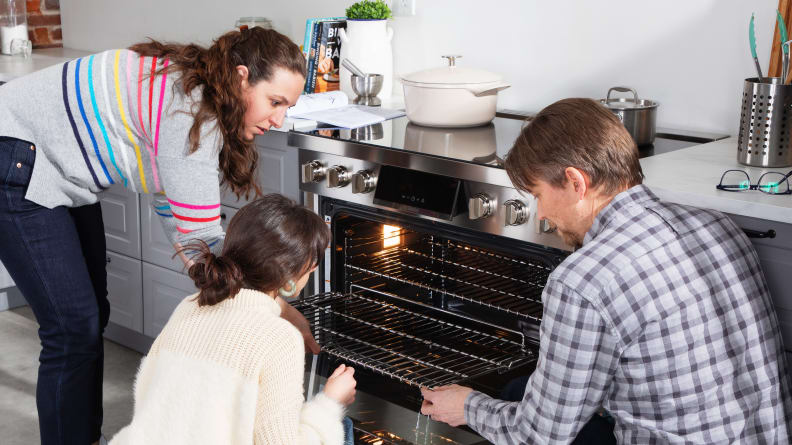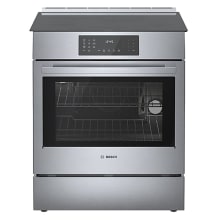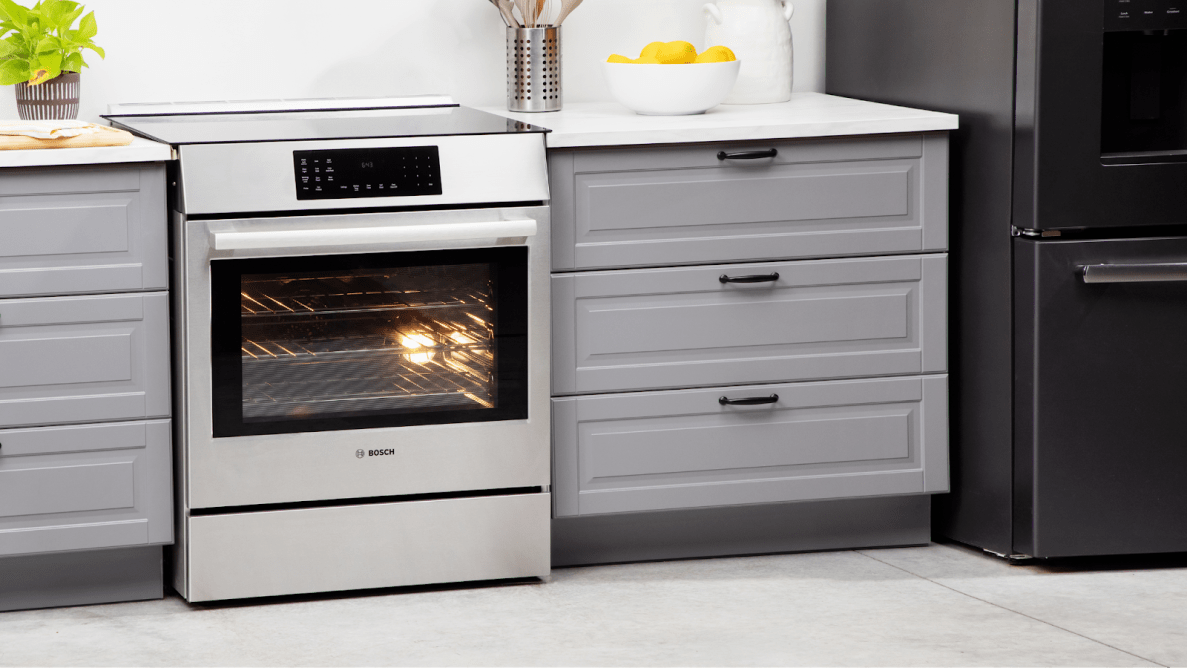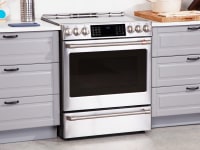Pros
-
Elements and oven heat up quickly
-
Easy to clean
-
Easy-to-use touch controls
Cons
-
Burner placement may be awkward
-
Preheat and boiling rates slower than average
About the Bosch HII8057U 800 Series Induction Range

This 30-inch Bosch induction range has an ultra-sleek design due to a lack of knob controls.
- Fuel type: Induction
- Dimensions: 36.5" x 31.5" x 28.875" (H x W x D)
- Oven capacity: 4.6 cubic feet
- Slide-in vs freestanding: Slide-in
- Finishes: Stainless steel
- Number of burners/elements: 4
- Number of oven racks: 3
- Number of oven rack positions: 6
- Control panel: Cooktop touch control
- Oven settings: Bake, Broil, Convection Bake, Convection Broil, Convection Multi-Rack, Pizza, Proof, Warm, Warming drawer, Self-clean
- True convection: Yes
- ADA compliant: No
- Energy Star rated: No
- User manual: Bosch HII8057U induction range manual
This slide-in induction range features a cooktop with a slight overhang that's designed to bleed onto the surrounding countertop. It houses four burners of varying sizes: The two front burners are each six inches, while the back-left burner is nine inches, and the back-right is 11 inches in circumference.
Instead of knobs to control the burners, the controls are touch-sensored and housed in the middle of the cooktop. Each burner has temperature-control settings ranging from one to nine, and there are also settings for speed boost, auto chef technology, and a cooktop timer.
The oven features 4.6 cubic feet of space, with six available rack positions and three oven racks. It boasts a wide variety of settings, including convection baking, self-cleaning, and more, which can be accessed via the touchscreen control panel on the oven door. There's also an under-oven drawer that is spring-loaded and opens with a push.
How we test ranges

We evaluate every aspect of the oven's usability and discuss testing results.
We have lab facilities in Cambridge, Mass., where we test all large appliances in-house—from refrigerators to dishwashers and beyond.
When it comes to testing ranges, we follow specific protocols and collect scientific data on a variety of factors: We test oven insulation through thermal imaging, monitor burners with a thermocouple thermometer, and conduct water-boiling and cookie-baking tests to evaluate speed and even heating.
Here’s more information on how we test ranges.
What we like
The cooktop has excellent burner control

We found that this cooktop can achieve precise temperatures—from low simmers to high sears.
Impressive cooktop temperature control is expected on an induction range, and the Bosch HII8057U is no exception.
During testing, we found that both low ends and high ends of the burner temperatures are excellent: The average low is about 104°F, which is below the melting point of most chocolates, while the average high is 689°F, which is excellent for searing meat but not high enough to damage cookware. There are nine different temperature settings for each burner, so it's easy to achieve the appropriate heating level for whatever you're cooking.
The burners also offer a speed boost setting, which boiled water 28% faster than when set to the highest regular temperature setting during our tests. Speed boost can only be used with one burner at a time, but since it's unlikely that users will often be boiling two pots of water at once, we still found this to be a useful feature.
The oven boasts accurate temperatures and even heating

Temperatures stayed impressively accurate and food baked evenly in this Bosch range.
Without a tool like an oven thermometer, how can you trust that setting your oven to 350°F will deliver the right temperature? When testing ranges, we use a thermocouple thermometer inserted into the oven set to 350°F, then monitor its fluctuations over the course of an hour. And typically, temperatures are less accurate than you would expect.
But we found that the Bosch HII8057U boasted extremely accurate temperatures—which we don't often see in most ranges we test—and long-term averages stayed at or very close to 350°F. There were some fluctuations over the hour, but that likely won't impact any baking results.
More importantly, our baking tests showed that the oven produces impressively even results. Cookies turned out to be practically identical in color, thanks to the true convection technology that uses a fan for even heating. This oven also offers multi-rack mode, which aids in even baking results for two or three racks at the same time.
Even the broiler setting—often notorious for yielding uneven heating results—proved to produce even browning during our tests. That's thanks to the upper heating element expanding across the width of the oven (most ovens only have heating elements that are concentrated in the middle).
The build quality is impressive
As you may expect from a high-end brand like Bosch, the build quality of this 800 Series induction range is impressive. From the oven door, which holds its position when partially open and won't fall open on its own, to the storage drawer, which has a push function to slide open and closed without slamming—this range has some elevated details.
This level of build quality is also evident in the insulation. When we used thermal imaging equipment, we were impressed to see how well this range keeps heat in. This is a crucial factor in all ranges because it ensures that external elements—like the door handles—stay cool to the touch, while also ensuring that the appliance is energy efficient without leaking heat into your home.
What we don’t like
The cooktop controls come with a steep learning curve

The touch controls on this range are sleek, but they're not intuitive—and they come with hiccups.
If you're splurging for this range and already preparing yourself for the switch to induction cooking, you may be frustrated by the extreme learning curve of the burner controls.
Besides the fact that touch controls, in general, are not as intuitive as knobs (at least, not at first), the Bosch HII8057U controls require a little extra patience.
Firstly, they're not as touch-sensitive as something like your smartphone, for safety reasons, so you'll need to hold each button down for a few seconds for it to be effective. They won't work at all until an induction-compatible pan is placed on the burner, so you can't crank up the burners ahead of time.
Second, the touch controls are prone to error when in contact with liquid, which can be a problem in an environment that's typically prone to spills. When we tried using the cooktop with a little drop of water, the touch controls no longer recognized our touch; eventually, the burners shut off altogether.
This can be particularly frustrating when it comes to condensation drippage from cookware lids or even food spills, which are both extremely common during cooking.
The burner layout is odd

The layout of each heating element looks haphazard, and it leaves unusable space that could have accommodated another burner.
This cooktop features only four cooking elements, and one of them is oddly placed in the middle-right quadrant of the surface.
This leaves a lot of unused space on the right-hand side of the cooktop, which may have been better used as an additional burner or warming element. Instead, it makes the cooktop look awkwardly laid out.
Oven preheat and water boiling rates are slower than average

It takes longer than average for this range to heat up—both on the cooktop and in the oven.
One of the main benefits of induction cooking is speed. While gas and electric ranges in our testing average around 130 seconds to boil one pint of water, induction averages just 70 seconds—a significant and noticeable difference.
The average boiling rate for this cooktop is about 105 seconds, and without the Speed Boost setting, it could be even slower. The largest burner, which is most likely to be used for boiling larger volumes of water, scored a faster 87 seconds. While this is still speedier than its gas and electric counterparts, it's not on par in the induction landscape.
The oven preheat function also lags with this range, averaging around 16 minutes, which is 5 minutes slower than the average for induction ranges. There is a fast preheat setting—which cuts down four minutes—and brings the preheat time closer to the average value. (Given that there's a speedier preheat option, why wouldn't that be the standard?)
Our testing uses a 208 V power supply, so are likely to see faster performance if you have a 240 V supply at home.
What owners are saying
This range has earned a 4.2-star rating on the Bosch website from 52 reviewers. Owners praise its speedy induction cooking results and sleek design.
Disappointed reviews highlight hiccups with the touch controls, including the etching being hard to read and water dripping from cookware impacting their effectiveness. Other common complaints include the layout of the cooktop burners and the warming drawer jutting out.
Warranty
Bosch consistently offers a limited warranty of one year for both the entire appliance and parts and labor for all of its ranges, which is on par with industry standards.
Should you buy the Bosch HII8057U 800 Series Induction Range?
Maybe, if you don't mind pre-heat lag time, but there are better values out there

This range boasts a uniquely modern feel, but users should be wary of its inherent learning curve.
This range comes with a lot of the impressive Bosch features we've come to love, like excellent build quality and precise temperature controls. Its cooktop touch controls mean the appearance is ultra-minimalist, making for a uniquely sleek look in the kitchen.
However, its steep price tag comes with a few downsides. Despite delivering decently speedy results, it falls on the slower end of other induction ranges we've tested. The touch controls have imperfections that may be frustrating for some users. Given that this range is priced at a premium, many could expect a more pleasant user experience. For a similarly priced range with more user-friendly controls and speedier cooking results, check out the Café CHS900P2MS1.

This sleek Bosch induction range features modern touch controls for the burners, but falls short when it comes to speed.
Meet the testers
Monica is Reviewed's Kitchen & Cooking editor and an avid home cook; she's been testing a wide range of kitchen products at Reviewed for three years. Previously the Digital Editor at Culture Cheese Magazine (and a former barista), she's also had her work published in The Boston Globe, Modern Luxury, Boston Magazine, and more.

Dr. Dave Ellerby
Chief Scientist
Dave Ellerby has a Ph.D. from the University of Leeds and a B.Sc. from the University of Manchester. He has 25+ years of experience designing tests and analyzing data.
Checking our work.
Our team is here to help you buy the best stuff and love what you own. Our writers, editors, and experts obsess over the products we cover to make sure you're confident and satisfied. Have a different opinion about something we recommend? Email us and we'll compare notes.
Shoot us an email




